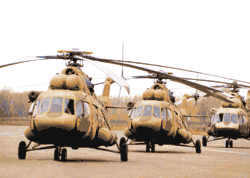 The Royal Nepal Army is embarking on its largest-ever purchase of weapons: 50,000 assault rifles over the next five years, two Russian Mi-17 helicopters to be delivered in January, and new German guns already ordered. More purchases are being discussed: a Super Puma helicopter, even Russian Mi-24s. The total price tag: $70 million. Add to this the logistical support needed for the paramilitary Armed Police Force, and you wonder, how are we going to pay for all this?
The Royal Nepal Army is embarking on its largest-ever purchase of weapons: 50,000 assault rifles over the next five years, two Russian Mi-17 helicopters to be delivered in January, and new German guns already ordered. More purchases are being discussed: a Super Puma helicopter, even Russian Mi-24s. The total price tag: $70 million. Add to this the logistical support needed for the paramilitary Armed Police Force, and you wonder, how are we going to pay for all this? Five arms suppliers from Korea, Germany, Israel, the United States and Belgium are hoping to win the contract to replace the army's ageing self-loading rifles (SLR). The bidding process began in September, but no decision yet.
And then there are reports that the army is also thinking about second-hand reconditioned Mi-24 helicopter gunships of the type seen in the film Rambo II. The army's earlier effort to buy a French Super Puma helicopter AS 332 L2 with a price tag of $10.8 million for VIP transport remains stuck in the parliament's Public Accounts Committee (PAC). A defence analyst told us the offer was to trade in an existing Super Puma (valued at $5 million) for four Soviet Afghan vintage Mi-24 gunships at $1 million each.
The Nepali tax-payer will be footing bill for the army's $70 million shopping list, and has the right to ask: who are we defending ourselves against? Will the money be diverted from vital development programmes? And, most of all, can we afford it?
"Security is a national priority, but we have to redefine security," argues Dr Chaitanya Mishra, sociologist and former member of the National Planning Commission. "Weapons don't make a country like ours more secure, our security comes from better health, better education, guaranteed civil liberties."
Assistant Home Minister Devendra Raj Kandel is exasperated by all this dove talk. "We need transport helicopters, the police needs at least two," he told us. "If we cannot find donors, we may even have to buy them, to improve mobility." Kandel was quoted by media recently saying security forces would soon be getting 10 transport helicopters from the United States as a gift. He told us he was misquoted. However, sources told us the Americans have made an offer of Bell UH-1 Huey helicopters for the APF.
Still, with the money the army is about to spend on guns and helicopters, we could build thousands of primary schools, 50 new district hospitals and 5,000 bridges all over the country. But the government, rattled by the Maoist insurgency and a stalled peace process, has endorsed the army's plan to upgrade. This being Nepal, a lot of eyes are on who wins the deals and who runs off with the kickbacks.
To be sure, parliamentary oversight is working. The purchase of the two Mi-17s has been the most transparent defence purchase to date, having being approved by both the government and the PAC, the parliament's spending watchdog. The very fact that the military is complaining bitterly that procedures are too cumbersome means that the PAC is doing its job, even though it is hobbled by rules that prevent it from investigating anything with a "security" tag.
That is why little is known about the other deals in the pipeline, and information for this article had to be gathered from local agents of prospective suppliers. The army is currently evaluating five suppliers for the 50,000 rifles, which it says it needs to replace its SLRs. The offers quoted by suppliers for the rifles range from $600-970 apiece. On the shortlist are the Daewoo K2, the Heckler and Koch G36, the Colt M16, and rifles made by FN Herstal and Galil. "This is not like buying a new CD," one army source told us. "The new weapon needs to be rugged, suited to our conditions and cheap."
If that is true, then the weapon conspicuous by its absence from the shortlist is the Russian Kalashnikov, the famous AK-47 which cost under $500. The army wants to standardise its arsenal, and is trying to switch from 7.76mm to 5.56mm calibre weapons. The 5.56mm give a soldier more fire-power, while the 7.76mm has longer range.
With the ceasefire in danger of being broken, the $70 million question is: can this country to afford to splurge on weapons, or is it going to buy only what is appropriate and necessary?


